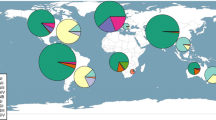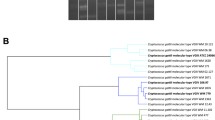Abstract
Two strains resembling the neurotropic fungus Ochroconis gallopava were isolated from hot spring river water (IFM 54738 and IFM 54739). The isolates showed optimal growth at 42°C, while the maximum growth temperature was 49°C, thus having temperature relationships similar to those of O. gallopava. Colonies were light olive green, with a color change to dark reddish brown after several passages, which was also observed in O. gallopava. Conidia were indistinguishable from those of O. gallopava. The antifungal susceptibility profile of the isolates was also similar to that of O. gallopava, except for a lower susceptibility to micafungin. The two isolates had 100% homologous rRNA genes including the internal transcribed spacer (ITS) region and the D1/D2 region of the large subunit. The gene fragments, as O. gallopava, could be amplified with species-specific rDNA primers, and loop-mediated isothermal amplification designed for O. gallopava yielded positive results in the two isolates. However, homologies with O. gallopava in ITS and D1/D2 regions were 79.2 and 95.9%, respectively, widely exceeding generally accepted species boundaries. These differences were corroborated in virulence tested in experimental infection. The two isolates did not kill a mouse even until 28 days. However, mortalities of four O. gallopava strains ranged from 40 to 100%. The new isolates mainly affected the kidneys; whereas O. gallopava had a strong preference for the brain. We therefore propose a new species, Ochroconis calidifluminalis, for the two isolates.





Similar content being viewed by others
Abbreviations
- 5-FC:
-
Flucytosine
- AMB:
-
Amphotericin B
- CBS:
-
CBS-KNAW Fungal Biodiversity Centre (Centraalbureau voor Schimmelcultures)
- CMA:
-
Cornmeal agar
- DDBJ:
-
Center for Information Biology and DNA Data Bank of Japan
- FCZ:
-
Fluconazole
- ICZ:
-
Itraconazole
- ITS:
-
Internal transcribed spacer
- LAMP:
-
Loop-mediated isothermal amplification
- LSU:
-
Large subunit
- MCF:
-
Micafungin
- MCZ:
-
Miconazole
- MIC:
-
Minimal inhibitory concentration
- MOPS:
-
3-(N-Morpholino) propanesulfonic acid
- OA:
-
Oatmeal agar
- PDA:
-
Potato dextrose agar
- SEM:
-
Scanning electron microscope
- SSU:
-
Small subunit
- VCZ:
-
Voriconazole
References
de Hoog GS, Guarro J, Gené J, Figueras MJ. Atlas of clinical fungi. Utrecht, The Netherlands: Centraalbureau voor Schimmelcultures; 2000. p. 82–3.
Yarita K, Sano A, Murata Y, Takayama A, Takahashi Y, Takahashi H, et al. Pathogenicity of Ochroconis gallopava isolated from hot springs in Japan and a review of published reports. Mycopathologia. 2007;64:135–47.
Hollingsworth JW, Shofer S, Zaas A. Successful treatment of Ochroconis gallopavum infection in an immunocompetent host. Infection. 2007;35:367–9.
Shoham S, Pic-Aluas L, Taylor J, Cortez K, Rinaldi MG, Shea Y, et al. Walsh. Transplant-associated Ochroconis gallopava infections. Transpl Infect Dis. 2008;10:442–8.
Mayer N, Bastani B. A case of pulmonary cavitary lesion due to Dactylaria constricta var. gallopava in a renal transplant patient. Nephrol. 2009;14:262.
Al-Doory Y. Laboratory medical mycology. Philadelphia, USA: Lea & Febiger; 1980. p. 117.
Takahashi H, Takahashi-Kyuhachi H, Takahashi Y, Yarita K, Takayama A, Inomata T, et al. An intrafamilial transmission of Arthroderma benhamiae in Canadian porcupines (Erethizon dorsatum) in a Japanese zoo. Med Mycol. 2008;46:465–73.
Stamatakis A, Hoover P, Rougemont J. A rapid bootstrap algorithm for the RAxML web servers. Syst Biol. 2008;57:758–71.
Balajee SA, Borman AM, Brandt ME, Cano J, Cuenca-Estrella M, Dannaoui E, et al. Sequence-based identification of Aspergillus, Fusarium, and Mucorales species in the clinical mycology laboratory: where are we and where should we go from here? J Clin Microbiol. 2009;47:877–84.
Ohori A, Endo S, Sano A, Yokoyama K, Yarita K, Yamaguchi M, et al. Rapid identification of Ochroconis gallopava by a loop-mediated isothermal amplification (LAMP) method. Vet Microbiol. 2006;14:359–65.
Clinical and Laboratory Standards Institute. Reference method for broth dilution antifungal susceptibility testing of filamentous fungi—second edition: Approved standard M38-A2. Wayne, Pennsylvania, USA: Clinical and Laboratory Standards Institute (CLSI); 2008.
Sano A, Miyaji M, Nishimura K, de Franco MF. Studies on the relationship between the pathogenicity of Paracoccidioides brasiliensis in mice and its growth rate under different oxygen atmospheres. Mycopathologia. 1991;114:93–101.
Dixon DM, Salkin I. Morphologic and physiologic studies of three dematiaceous pathogens. J Clin Microbiol. 1986;24:12–5.
Vukmir RB, Kusne S, Linden P, Pasculle W, Fothergill AW, Sheaffer J, et al. Successful therapy for cerebral phaeohyphomycosis due to Dactylaria gallopava in a liver transplant recipient. Clin Infect Dis. 1994;19:714–9.
Kralovic SM, Rhodes JC. Phaeohyphomycosis caused by Dactylaria (human dactylariosis): report of a case with review of the literature. J Infect. 1995;31:107–13.
Bowyer JD, Johnson EM, Horn EH, Gregson RM. Ochroconis gallopava endophthalmitis in fludarabine treated chronic lymphocytic leukemia. Br J Ophthalmol. 2000;84:117.
Mazur JE, Judson MA. A case report of a dactylaria fungal infection in a lung transplant patient. Chest. 2001;119:651–3.
Malani PN, Bleicher JJ, Kauffman CA, Davenport DS. Disseminated Dactylaria constricta infection in a renal transplant recipient. Transpl Infect Dis. 2001;3:40–3.
Wang TK, Chiu W, Chim S, Chan TM, Wong SS, Ho PL. Disseminated Ochroconis gallopavum infection in a renal transplant recipient: the first reported case and a review of the literature. Clin Nephrol. 2003;60:415–23.
McGinnis MR, Pasarell L. In vitro testing of susceptibilities of filamentous ascomycetes to voriconazole, itraconazole, and amphotericin B, with consideration of phylogenetic implications. J Clin Microbiol. 1998;36:2353–5.
Meletiadis J, Meis JFG, Horré R, Verweij PE. Short communication: in vitro antifungal activity of six drugs against 13 clinical isolates of Ochroconis gallopava. Stud Mycol. 1999;43:206–8.
Espinel-Ingroff A. In vitro fungicidal activities of voriconazole, itraconazole, and amphotericin B against opportunistic moniliaceous and dematiaceous fungi. J Clin Microbiol. 2001;39:954–8.
Acknowledgments
This study was supported in part by the Special Research Fund for Emerging and Re-emerging Infections from the Ministry of Health, Labour, and Welfare, Japan, to Drs. Katsuhiko Kamei and Ayako Sano. We are grateful to Dr. Hitoshi Okada and Dr. Masako Osumi, Integrated Imaging Research Support, Tokyo, Japan, for providing SEM pictures.
Author information
Authors and Affiliations
Corresponding author
Rights and permissions
About this article
Cite this article
Yarita, K., Sano, A., Samerpitak, K. et al. Ochroconis calidifluminalis, a Sibling of the Neurotropic Pathogen O. gallopava, Isolated from Hot Spring. Mycopathologia 170, 21–30 (2010). https://doi.org/10.1007/s11046-010-9292-7
Received:
Accepted:
Published:
Issue Date:
DOI: https://doi.org/10.1007/s11046-010-9292-7




